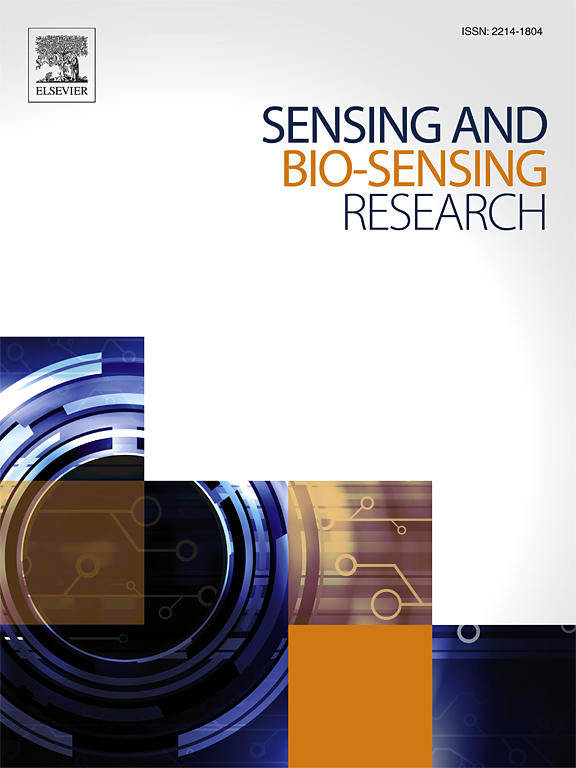Detection of petrochemicals using photonic crystal fiber (PCF) in terahertz domain
IF 5.4
Q1 CHEMISTRY, ANALYTICAL
引用次数: 0
Abstract
A photonic crystal fiber (PCF) with a hexahedron core has been introduced for usage in petrochemical sensing operations. The performance of the proposed sensor has been statistically analyzed in the frequency band of 1.0 to 3.0 THz. Pure petrol, kerosene, and diesel are poured into the hexahedron core hole. The Finite element Method (FEM) is handled for the simulation and precise calculation and investigation. The sensor utilizing PCF exhibits a relative sensitivity of about 97.80 %, 97.45 %, and 96.25 % and a confinement loss of approximately 1.88 × 10−8 dB/m, 1.90 × 10−8 dB/m, and 1.85 × 10−8 dB/m at 2.20 THz for all investigated Petrol, Kerosene, and Diesel petrochemicals. Moreover, effective areas are values of 7.75 × 10−8 m2, 7.80 × 10−8 m2, and 6.98 × 10−8 m2, and the effective material loss for Petrol, Kerosene, and Diesel of 0.0066168 cm−1, 0.0066955 cm−1 and 0.0066988 cm−1, respectively at 2.20 THz. Both 3D printing and extrusion can be used to create this photonic crystal fiber (PCF) sensor. In addition, this heptagonal photonic crystal fiber sensor will be used for biomedical sensing and various industry fields related to sensing sectors.
利用光子晶体光纤(PCF)在太赫兹域探测石油化工产品
介绍了一种具有六面体芯的光子晶体光纤(PCF),用于石油化工传感作业。在1.0 ~ 3.0 THz频段对传感器的性能进行了统计分析。将纯汽油、煤油和柴油倒入六面体岩心孔中。采用有限元法进行了数值模拟,并进行了精确的计算和研究。利用PCF的传感器在2.20太赫兹下的相对灵敏度分别为97.80%、97.45%和96.25%,约束损耗分别为1.88 × 10−8 dB/m、1.90 × 10−8 dB/m和1.85 × 10−8 dB/m。此外,有效面积分别为7.75 × 10−8 m2、7.80 × 10−8 m2和6.98 × 10−8 m2,汽油、煤油和柴油在2.20 THz下的有效材料损失分别为0.0066168 cm−1、0.0066955 cm−1和0.0066988 cm−1。3D打印和挤压都可以用来制造这种光子晶体光纤(PCF)传感器。此外,这种七方光子晶体光纤传感器将用于生物医学传感和与传感部门相关的各种工业领域。
本文章由计算机程序翻译,如有差异,请以英文原文为准。
求助全文
约1分钟内获得全文
求助全文
来源期刊

Sensing and Bio-Sensing Research
Engineering-Electrical and Electronic Engineering
CiteScore
10.70
自引率
3.80%
发文量
68
审稿时长
87 days
期刊介绍:
Sensing and Bio-Sensing Research is an open access journal dedicated to the research, design, development, and application of bio-sensing and sensing technologies. The editors will accept research papers, reviews, field trials, and validation studies that are of significant relevance. These submissions should describe new concepts, enhance understanding of the field, or offer insights into the practical application, manufacturing, and commercialization of bio-sensing and sensing technologies.
The journal covers a wide range of topics, including sensing principles and mechanisms, new materials development for transducers and recognition components, fabrication technology, and various types of sensors such as optical, electrochemical, mass-sensitive, gas, biosensors, and more. It also includes environmental, process control, and biomedical applications, signal processing, chemometrics, optoelectronic, mechanical, thermal, and magnetic sensors, as well as interface electronics. Additionally, it covers sensor systems and applications, µTAS (Micro Total Analysis Systems), development of solid-state devices for transducing physical signals, and analytical devices incorporating biological materials.
 求助内容:
求助内容: 应助结果提醒方式:
应助结果提醒方式:


